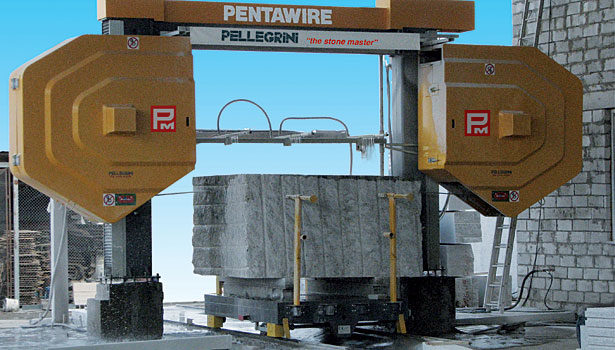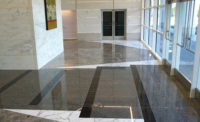Miles Supply is a family company based in Barre, VT, that specializes in working with quarries. “To me, the big advantage of a multi-wire saw is the ability to get more production out of the same amount of time, compared to a single-blade or single-wire machine,” said Rob Donahue, the equipment sales manager for the company.
Depending on the material that is being cut, the speed of cutting is comparable to or faster than gangsaws, but because the multi-wire saw is cutting several slabs at the same time, the amount of slabs being produced increases. “We did a real quick study,” said Donahue. “We got 40% more yield in the same eight-hour period by using a five-wire machine. The speed of the cut of the single-blade saw was maybe 10 minutes to make a cut on that specific piece, where the wired saw took maybe 25 minutes to make a cut, but we were making five cuts at the same time.”
Coldspring, headquartered in Cold Spring, MN, has been serving the architectural, memorial, residential and industrial markets for more than 115 years, and the company still uses gangsaws on a limited basis for cutting thinner material, but has been switching more of its production to diamond wire, primarily to gain the advantage of shorter lead times. The company also designed its own multi-wire saws and still operates 19 of those today throughout North America. Recently, Coldspring purchased three saws from Wires Engineering (Cofiplast) of Italy.
“For Coldspring, the decision was largely about lead time,” said Josh Reitmeier, Director of Sales — tooling division for Coldspring. “Our commitment to meet our customer’s timeline was being impeded by the slow cycle time on the gangsaws. The options we faced were to carry more inventories or implement a faster process. We considered quite a few options when we made these purchases and probably the most critical decision factor was the ability to change thickness from cut to cut without a timely and costly changeover. The drum design of the falcon saws from Wires Engineering has achieved that for us.”
Multi-wire saws also come in a variety of sizes that range from two wires all the way up to 72 wires. “Pellegrini has a family of machines that are very versatile with multi-wire,” said Donahue. “They have two-wire machines, five-wire, 16-, 34- and even 72-wire machines. The five-wire machine is flexible; you can cut multiple sizes of slabs in the same pass. It is very easy to make the adjustments. Pellegrini’s biggest advantage is its electro-hydraulic tensioning system. We have two tensioning systems going on independent fly wheels that are making micro adjustments as they cut through the stone. Each block of granite and marble has different consistencies throughout, so a saw being able to detect those changes and hardnesses can make slight adjustments to give the wire more tension while it’s cutting.”
The electro-hydraulic tensioning system figures the tensioning value of each wire, which is automatically kept by the machine into a correct range of values, adjusting it according to the presence of harder or softer portions of the stone during cut. The oil of the hydraulic system is incompressible fluid, and it grants an immediate and reliable response during the tensioning of each wire, avoiding the continuous “loosing-tensioning” effect on the wires. This solution grants a long-lasting life of a wire as well as cutting precision.
“The presence of big tensioning flywheels and the big motor drum offers the attractive advantage to reduce the stress on the diamond wires, soliciting the minimum possible fatigue of the wire itself,” said Nicola De Cesare of Pellegrini. “This grants life of the wires higher than the average value in the market, optimizing at the best the investment of the diamond wires; moreover, reducing the frequency time in changing the wires, a continuous cutting production is granted without facing long and unproductive dead times.”
According to Coldspring, the energy costs are much lower on the diamond wire saws, but from a total cost standpoint, that is offset by the higher cost of consumables, the wire. “While the cost of diamond wire has dramatically dropped in recent years, our cost per square foot to cut material 2 inches and thinner remains lower with the steel shot gangsaws, but the difference has become very minimal,” said Reitmeier. “Cutting slabs thicker than 2 inches is now cheaper with diamond wire.”
Flexibility is also a feature of the multi-wire saw. According to Reitmeier, because of the lower cost to operate the saws, as well as the shorter setup time, you do not have to be as concerned with only cutting partial blocks if you don’t have the demand for a whole block. “With the traditional shot saw method of cutting, in order to keep the per-square-foot cost of operating low, the saw needs to be completely full and every block needs to be completely cut, even if demand doesn’t require it. That results in excess slabs added to inventory.”
Before rushing out to buy a multi-wire saw, Reitmeier said to make sure to consider the number of wires the saw is capable of running at one time. “Before rushing to buy the biggest saw on the market, it is important to understand the demand that will be put on the saw and buy accordingly,” said Reitmeier. “The upfront cost to put diamond wire on the largest saws available now is upwards of $100,000. This is sometimes overlooked when contemplating a wire saw purchase.”




